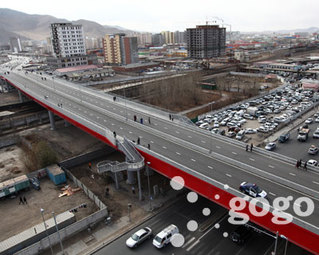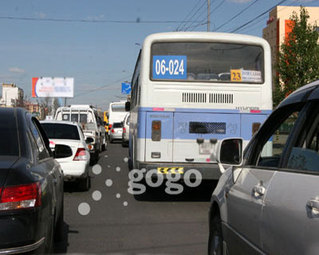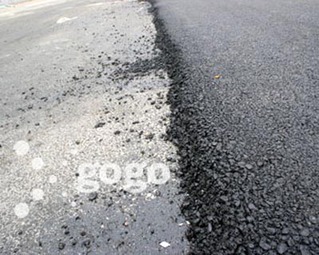Columbus Fund
Metaphorically speaking, people who
have not fully understood where they were in the past, where they are heading
and where they are now are sometimes compared to Christopher Columbus, who set
sail for India and discovered America without knowing it and declared it was
East India.
Here
we talk not necessarily about “Columbuses” that are increasing in number in
Mongolian politics today, but mostly on their “artistic creations” while in
power. They are not only unable to catch up to the current speed of social and
economic development but are also interrupting our daily activities. One of the
clearest, most irritating
interruptions is caused by the condition of roads in Mongolia today. It is time
we talked about this issue and its future and change the situation for better.
It does not take even a year before
the new roads Mongolians have built need the potholes filled. These roads have
become an inevitable hell. We come across bumps too often that the ride in our
cars is miserable.
However,
the Japanese have built the Sun Road and the Sun Bridge in Ulaanbaatar City,
all of which were properly built and supervised. This clearly shows the fact
that better management and efficient spending of investment funds can determine
the good quality of roads and bridges under construction.
Roads are the mirror of development
In the decade of 2010-2020, the
period when our economy is going to triple, Mongolia’s road network is proposed
to expand four times as much. Currently, Mongolia has 4000 kilometers of constructed
roads, two thirds of which are hard surfaced and the rest are gravel surfaced. If
we count the more-than-one-thousand-kilometers-long improved bitumen surfaced roads
and the 42700-kilometers dirt or earth roads, Mongolia has a road network of
50,000 kilometers. This is one of the few countries where drivers take international
gravel or dirt roads to their neighbors.
Mongolia’s hard-surfaced roads, which
are considered one of the most basic necessities of a civilization, need to be
lengthened five times in length during this decade. In other words, Mongolians
will need to make an investment for 1000 kilometers of roads every year and
manage and maintain it efficiently.
According to a report released by the
Asian Development Bank, Mongolia spends 1.5 to 2 percent of its GDP on the
roads sector, which is similar to that of many other developing countries.
However, the outcome has not been so beneficial that Mongolia has been building
only 100 kilometer of roads on average every year, which is a relatively less
than compared to international levels.
Today, the government of Mongolia is
measuring its investment by the inputs or the amount of money they spend while
people are demanding to measure it by the outcomes, results and benefits of the
investment. Let us look at some issues concerning the Road Fund, which is the
most pressing problem in the road sector which includes such as benefits of
investment, development of the roads sector and the quality of governance.
The lost hub
The Road Fund was established twenty
years ago with the purpose of financing investments in the roads sector and its
rights and responsibilities were ratified by the Law on Roads in 1998. However,
like many other laws in Mongolia, this law has not been implemented well.
The Road Fund’s revenue was
constituted by tax on petrol and diesel fuel imports at first. Then, there have
been decisions made to constitute it’s revenue by other sources such as vehicle
taxes, public budget and foreign loans. The implementation of these decisions
has not always been consistent.
The customs duty on petrol was set
in 1995 that the tax imposed on flammable or combustible substances was MNT
20,350 a tonne if the octane rating of petrol was lower than 90 while it was MNT
25,700 if the octane rating was higher than 90 and MNT 2,140 for a tonne of
diesel fuel. However, the tax collected did not fully go to the Road Fund. Also,
even though a special tax was imposed on fuel, it was not always spent on road
financing. Although the tax collected was supposed to be invested in
establishing local road funds in the city and provinces with the purpose of
collecting fees on vehicles, local administrations ended up keeping the money
and spending it for other purposes.
Small-size cars have been imposed
MNT 500 while MNT 800-1500 has been collected from all other size vehicles
since toll roads were introduced by the Department of Road in 2002. Although
MNT 830 million was collected from toll roads in 2008, 80 percent of it was
spent on the procedures of collecting the charges. The average cost of
collecting road tolls equals about 10 percent of the total revenue. Then, do we
really need to keep the toll roads and interrupt the traffic when the
expenditure cannot be covered?
The Road Fund had lost slowly its main
function to build roads to the related ministry, which did not even allow them,
the function as a “road agency”, and to fully own the financial resources needed
for repairing and maintaining the roads under their authority.
The Road Fund has been not been fulfilling
their duties, and the government has not overseen their operations effectively.
This is what has caused today’s road conditions to become so pathetic. By international standards, generally
there are two types of road
maintenance: routine (short-term) and periodic (mid-term). We have only been
doing the routine maintenance and forgetting the periodic maintenance, which is
why Mongolia now has a very costly standard where it is choice between either
all roads in Mongolia are repaired every year or roads are rebuilt after ten
years. It is considered that, if routine maintenance are done timely and
periodic maintenance done every 4 to 5 years following the proper standards, paved roads do not need any rehabilitation works or reconstruction for
20-30 years at least.
Leverage and Road Board
Roads should originally be a
leverage for development that brings development to the countryside creating
jobs nationwide. However, it has been many years since people have been talking
about how it has become the influence for taking bribes, stealing from public
property, forcing one’s way into politics with money, breeding billionaires
from the government and getting to higher positions.
Nevertheless, we desperately need
our roads to be the real leverage for development and start using them in an
environmentally friendly way. This sector has to be developed in a way that
brings positive economic and ecological impacts by promoting responsible mining
and dust control and reducing environmental, land and pasture degradation.
Unfortunately, at this crucial
stage, money supposed to be spent on roads is disappearing without serving its
purpose and the governance has long become non-transparent. Therefore, it is
time we looked at the experiences of other countries and established a Road Board.
A national Road Board is an
institution that represents government, producers of road services’ suppliers
and customers. The main purpose is to organize tenders of road construction and
maintenance, release reports, implement projects and ensure that the capital
accumulated in the Road Fund is spent legally and appropriately for road sector
management.
The Road Board should also take part
in resolving many of the issues arisen from the capital city’s need to develop.
In order to reduce traffic jam, tasks such as building a highway that circles the
mountain in the south and linking parts of the city with circuit roads to ease
flow of traffic should be undertaken. Also, traffic lights and signs have to be
installed on roads in the countryside. In order to do that, conditions for
market competition have to be created.
The time has come for the Road Fund
to have a definite financial source, transparent management and efficient
operations that build high standard roads.
By Mr Jargalsaikhan
http://jargaldefacto.com/

By Mr Jargalsaikhan
http://jargaldefacto.com/
JARGALSAIKHAN DAMBADARJAA - 2012/10/24 14:08



 Замын санг 20 жилийн өмнө авто замын хөрөнгө оруулалтыг санхүүжүүлэх зорилгоор бий болгож, 1998 онд Авто замын хуулиар эрх, үүргийг нь баталгаажуулжээ. Гэвч Монгол Улсад мөрдөж буй бусад олон хууль, журмын адил энэ хууль “байнд ч биш, банзанд ч биш" туссаар ирэв. Замын сангийн орлогыг эхэндээ бензин болон дизель түлшний импортын татвараас, яваандаа зам ашиглалтын болон тээврийн хэрэгслийн татвар, улсын төсөв, гадаадын зээл зэрэг эх үүсвэрээс бүрдүүлэх шийдвэрүүд гарч, алдаг оног хэрэгжүүлж иржээ.
Замын санг 20 жилийн өмнө авто замын хөрөнгө оруулалтыг санхүүжүүлэх зорилгоор бий болгож, 1998 онд Авто замын хуулиар эрх, үүргийг нь баталгаажуулжээ. Гэвч Монгол Улсад мөрдөж буй бусад олон хууль, журмын адил энэ хууль “байнд ч биш, банзанд ч биш" туссаар ирэв. Замын сангийн орлогыг эхэндээ бензин болон дизель түлшний импортын татвараас, яваандаа зам ашиглалтын болон тээврийн хэрэгслийн татвар, улсын төсөв, гадаадын зээл зэрэг эх үүсвэрээс бүрдүүлэх шийдвэрүүд гарч, алдаг оног хэрэгжүүлж иржээ. Уг нь зам бол хөгжлийг хөдөөд авчирдаг, ажлын шинэ байр орон даяар бий болгодог хөгжлийн хөшүүрэг билээ. Харин Монголд авлига авах, нийтийн хөрөнгийг завших, улс төрд мөнгөөр зодож орох, төрөөс тэрбумтан төрүүлэх, төр засгийн өндөр албан тушаалд хүрэх хөшүүрэг болсныг хүн бүр ярьсаар олон жил боллоо. Гэтэл замыг хөгжлийн хөшүүрэг жинхэнээс нь болгож, байгаль орчиндоо ээлтэй байхаар ашиглах шаарддага тулгараад байдаг. Хариуцлагатай уул уурхайг хөгжүүлэх, байгаль орчин, хөрс, бэлчээрийн доройтол, тоосжилтыг бууруулах зэрэг эдийн засаг, экологийн эерэг үр дүнтэй байхаар энэ салбарыг хөгжүүлэх шаарддага тулгараад байна.
Уг нь зам бол хөгжлийг хөдөөд авчирдаг, ажлын шинэ байр орон даяар бий болгодог хөгжлийн хөшүүрэг билээ. Харин Монголд авлига авах, нийтийн хөрөнгийг завших, улс төрд мөнгөөр зодож орох, төрөөс тэрбумтан төрүүлэх, төр засгийн өндөр албан тушаалд хүрэх хөшүүрэг болсныг хүн бүр ярьсаар олон жил боллоо. Гэтэл замыг хөгжлийн хөшүүрэг жинхэнээс нь болгож, байгаль орчиндоо ээлтэй байхаар ашиглах шаарддага тулгараад байдаг. Хариуцлагатай уул уурхайг хөгжүүлэх, байгаль орчин, хөрс, бэлчээрийн доройтол, тоосжилтыг бууруулах зэрэг эдийн засаг, экологийн эерэг үр дүнтэй байхаар энэ салбарыг хөгжүүлэх шаарддага тулгараад байна.

